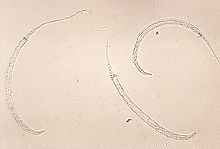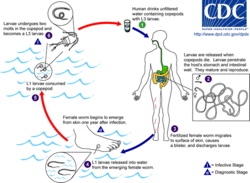- Dracunculus
-
This article is about the parasitic worm. For the genus of Arum lilies, see Dracunculus (aroid).
Dracunculus 
Dracunculus medinensis larvae Scientific classification Kingdom: Animalia Phylum: Nematoda Class: Secernentea Order: Camallanida Superfamily: Dracunculoidea Family: Dracunculidae Genus: Dracunculus Species D. alii
D. dahomensis
D. fuelliborni
D. globocephalus
D. insignis
D. lutrae
D. medinensis
D. ophidensisDracunculus is a genus of spiruroid nematode parasites in the family Dracunculidae. Some species infest humans, and alter their hosts’ behaviour in a way that supports the worm’s reproductive cycle. Dracunculus causes a blister to form on foot of the host, causing severe pain and boiling sensation. This will cause the human host to dip foot in water to sooth the pain which will cause the blister to burst, allowing reproductive larvae into the water where they can await the next host to infect.
The worms can reach a metre in length. If one simply pulls off the protruding head of the worm, the worm will break and leak high levels of foreign antigen which can lead to anaphylactic shock and fast death of the host. Hence it is important to remove the worm slowly (over a period of weeks). This is typically undertaken by winding the worm onto a stick (say, a matchstick), by a few centimetres each day.
Contents
Species
D. medinensis and D. insignis
The best known species is D. medinensis, known commonly as the Guinea worm. This parasite is frequently found in the subcutaneous tissues and muscles of humans, dogs, and sometimes cattle and horses. The medical name for this condition is dracunculiasis. The disease causes cutaneous nodules and subsequent ulcers. The anterior end of the adult female worm protrudes from the host animal's body, most commonly on a lower limb, through an ulcer. When the worm feels the presence of cold water, muscle contractions in its body cause its uterus (which fills the whole body cavity) to burst, releasing hundreds of thousands of first-stage larvae into the water, where they can find new hosts.[1]
D. insignis infects dogs and wild carnivores, causing cutaneous lesions, ulcers, and sometimes heart and vertebral column lesions. Like D. medinensis, it is also known as Guinea worm, as well as Dragon or Fiery Dragon.
DNA fingerprinting can differentiate between D. medinensis and D. insignis, which is important to efforts to eradicate dracunculiasis.[2]
Other species
D. fuelliborni parasitizes opossum, D. lutrae parasitizes otters, and D. ophidensis parasitizes reptiles.
Distribution
In 2011 only four countries still had the human-infecting Dracunculus medinensis – and of these, Ghana, Ethiopia and Mali have nearly eliminated it. Of the 1785 cases found in 2010, 1690 were in south Sudan, which is 38 per cent fewer than the number of cases in 2009.[3]
Life cycle
The life cycle was elucidated in 1870 when Alexei Pavlovich Fedchenko of Russia discovered the copepod crustacean intermediate host stages.
Rod of Asclepius
It has been suggested that the symbol once represented a worm wrapped around a rod; parasitic worms such as the guinea worm (Dracunculus medinensis) were common in ancient times, and were extracted from beneath the skin by winding them slowly around a stick. According to this theory, physicians might have advertised this common service by posting a sign depicting a worm on a rod. However plausible, no concrete evidence in support of this theory has been adduced.[4]
See also
*List of parasites (human)
References
- ^ "Dracunculiasis (Guinea Worm Disease) Eradication", Ernesto Ruiz-Tiben and Donald Hopkins, Advances in Parasitology, vol. 61 (2006), pp. 275-309.
- ^ Bimi et al., 2005
- ^ New Scientist: South Sudan's votes could kill an ancient disease
- ^ Emerson, John (July 2003). Eradicating Guinea worm disease: Caduceus caption. Social Design Notes. http://www.backspace.com/notes/2003/07/27/x.html. Retrieved 2007-06-15.
- Bimi, L.; et al. (2005). "Differentiating Dracunculus medinensis from D. insignis, by the sequence analysis of the 18S rRNA gene" (PDF). Annals of Tropical Medicine and Parasitology 99 (5): 511–517. doi:10.1179/136485905X51355. PMID 16004710. http://www.cartercenter.org/documents/2147.pdf. Retrieved 2007-02-27.
- "Dracunculus". Integrated Taxonomic Information System. http://www.itis.gov/servlet/SingleRpt/SingleRpt?search_topic=TSN&search_value=64153. Retrieved February 27, 2007.
Categories:- Parasites
- Nematodes
- Nematode stubs
- Parasite stubs
Wikimedia Foundation. 2010.

